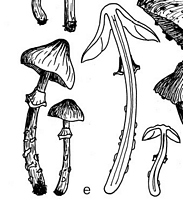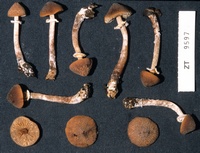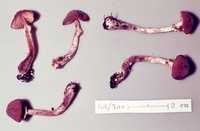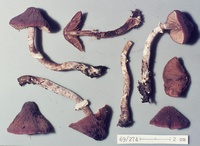|
 Descolea phlebophora Descolea phlebophora
BiostatusPresent in region - Indigenous. Non endemic
Images (click to enlarge)
Caption: Fig. 8. Descolea phlebophora. - a. Spores (2000 x). - b. Cheilocystidia (1000 X). - c. Cuticle
(500 X ). | 
Caption: Descolea phlebophora -Figs. 2e | 
Caption: Watercolour
Owner: G.M. Taylor | 
Caption: ZT9597
Owner: E. Horak: © Creative Commons Attribution-Noncommercial 3.0 New Zealand | 
Caption: ZT68-500
Owner: E. Horak: © Creative Commons Attribution-Noncommercial 3.0 New Zealand | 
Caption: ZT69-274, Isotype
Owner: E. Horak: © Creative Commons Attribution-Noncommercial 3.0 New Zealand |
Article: Horak, E. (1971). Studies on the genus Descolea. Persoonia 6(2): 231-248.
Description: Pileus 10-30 mm diam., hemispherical when young, later becoming campanulate or
umbonate, rarely flat and expanded; reddish brown, liver brown or sometimes dark
melleous; dry, hygrophanous, at the centre deeply wrinkled and radially veined, striate near
the margin, veil remnants absent. Lamellae adnexed, crowded; pallid brownish, ochraceous
or rusty brown at maturity; edge whitish, finely fimbriate. Stipe 30-70 X 2-6 mm,
cylindrical or attenuated upwards, solid, later fistulose; concolorous with the pileus or
lighter; dry, densely covered by white silky fibrils, towards the base with several white
conspicuous bands of the velum universale, never squarrose or scaly; ring white, striate
(sometimes smooth), persistent, immobile. Context brownish. Smell and taste fruity or
intensely farinaceous. Spores 8-11.5 X 5-6 µ, amygdaliform, minutely warted, warts
sometimes even covering the indistinct mucro, germ pore or plage absent. Basidia 25-34 X
5-8 µ, 4-spored. Cheilocystidia 20-35 X 5-10 µ, clavate or ampullaceous, indistinct,
forming a sterile zone at the gill edge. Cuticle consisting of clavate cells, 20-35 X 10-20 µ,
rarely 1-layered, usually forming several horizons (see Fig. 6), strongly encrusted with
brown pigment; membrane not gelatinized. All hyphae with clamp connections.
Habitat: HABITAT: Among litter, mainly in Nothofagus forests (N. cliffortioides, N. fusca, N.
menziesii; occasionally mixed with species of Leptospermum). New Zealand.
Notes: This species is easily recognizable by its deeply wrinkled and veined pileus and the conspicuous
white remnants of the velum partiale and velum universale. Thus D. phlebophora, which has
roughly the same ecological requirements as D. gunnii differs from it morphologically in the
absence of scales towards the base of the stipe and the liver brown colour of the pileus
respectively. Owing to these characters both taxa can be readily identified in the field.
|